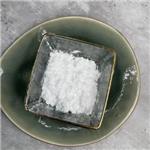Physical Properties
The anhydrous chloride is a pink solid; cubic crystals; deliquescent; density 2.977 g/cm3 at 25°C; melts at 650°C; vaporizes at 1,190°C; very soluble in water (~72g/100 mL at 25°C); soluble in alcohol; insoluble in ether.
The tetrahydrate has a rose color; monoclinic crystal structure; deliquescent; density 2.01 g/cm3; melts at 58°C; loses one molecule of water at 106°C and all water at 198°C; highly soluble in water (151 g/100mL at 8°C) and extremely soluble in boiling water (656 g/100mL at 100°C); soluble in ethanol; insoluble in ether.
Uses
Manganese(II) chloride is used in dyeing and printing textiles and as a disinfectant. It also is used in dry cell batteries; for the preparation of drying agents for paints and varnishes; as a catalyst in chlorination reactions; in the production of several manganese salts, including methylcyclopentadienylmanganese tricarbonyl used as a colorant for brick. In metallurgy, the compound is used as an alloying agent and is added to molten magnesium to produce magnesium-manganese alloys.
Preparation
Manganese(II) chloride is prepared by heating manganese(II) oxide, manganese dioxide, manganese(II) carbonate or manganese(II) hydroxide with hydrochloric acid:
MnO2 + 4HCl → MnCl2 + 2H2O + Cl2
MnCO3 + HCl → MnCl2 + H2O + CO2
When the product mixture is evaporated below 58°C, the tetrahydrate salt, MnCl2•4H2O is obtained.
Manganese(II) chloride is a by-product in the manufacture of chlorine from manganese dioxide and hydrochloric acid (the Weldon process).
Anhydrous chloride can be prepared by heating manganese(II) oxide or manganese(II) carbonate with dry hydrogen chloride; or by burning the metal in chlorine at 700°C to 1,000°C.
The anhydrous salt can also be obtained by slowly heating the tetrahydrate, MnCl2•4H2O in a rotary drier above 200°C or by dehydration in a stream of hydrogen chloride gas.
Reactions
Manganese(II) chloride forms double salts with alkali metal chlorides when mixed in stoichiometric amounts. Such double salts, which can decompose in water, may have compositions like KMnCl3 or K2MnCl4.
Manganese(II) chloride forms adducts with ammonia, hydroxylamine and many other nitrogen compounds. Many adducts are stable at ordinary temperatures. Examples are MnCl2•6NH3 and MnCl2•2NH2OH.
An aqueous solution can readily undergo double decomposition reactions with soluble salts of other metals, producing precipitates of insoluble salts of Mn(II) or other metals.
Description
Manganese, an essential nutrient, occurs in many foods of plant
and animal origin. The naturally occurring manganese levels vary
from about 2 0 ppm in nuts, cereals, dried fruits and non-leafy
vegetables to less than 1 ppm in animal products.
Manganous chloride tetrahydrate is pink translucent crystals which
are very soluble in water.1
.
Chemical Properties
MnCl2 is rose-colored deliquescent crystals that are very soluble in water,and melts at 650°C and boils at 1190°C. The tetrahedral form, MnCI2.4H20 , melts at 58°C and loses its water at 198°C and is used as a catalyst in paints,dyes,pharmaceuticals, and fertilizers, and for various other purposes.
Uses
Used mainly in the production of dry cell batteries
Uses
A novel high-spin hexanuclear Mn(III) cluster, [NaMn6(OMe)12(dbm)6]+, was synthesized via MnCl2 oxidation with simultaneous NaOMe promoted aggregation. This cluster has an unprecedented cyclic structure and 24 unpaired electrons in its ground state.1 Also used in the formation of an active Mn(0) species useful for radical cyclization reactions.2
Uses
Manganese chloride (MnCl2) is used in the pharmaceutical industry as a dietary supplement
and is added to fertilizers.
Uses
Manganese Chloride is a source of manganese that functions as a
nutrient and dietary supplement. it exists as crystals which are readily
soluble in room temperature (22°c) water and are very soluble in
hot water. see manganese.
General Description
Manganese (II) chloride (MnCl
2) might play a key role in integrin activation. Manganese is indispensable for brain function and is an essential cofactor for several key enzymes like superoxide dismutase and enzymes involved in neurotransmitter synthesis. Manganese can modulate iron and calcium homeostasis. Manganese is also used in the magnetic resonance imaging to increase contrast while examining neuronal connections and brain cytoarchitecture. High levels of manganese is toxic to central nervous system and causes Parkinson′s like symptoms called as manganism. MnCl
2 has been used in reverse transcription reaction mix to enhance the template-switching efficiency.
reaction suitability
core: manganese
reagent type: catalyst
Safety Profile
Poison by
intraperitoneal, subcutaneous, intramuscular,
intravenous, and parenteral routes.
Moderately toxic by ingestion. Experimental
teratogenic and reproductive effects.
Questionable carcinogen with experimental
carcinogenic data. Mutation data reported.
Explosive reaction when heated with zinc
foil. Reacts violently with potassium or
sodium. When heated to decomposition it
emits toxic fumes of Cl-. See also
MANGANESE COMPOUNDS and
CHLORIDES.
Purification Methods
It crystallises from water (0.3mL/g) on cooling. The red-rose tetrahydrate melts at ~52o and forms the dihydrate salt which loses all its H2O at 198o to give MnCl2. It is soluble in EtOH.







